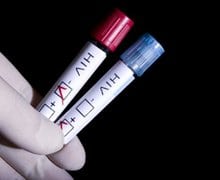We are the ethnic group most affected by HIV
African Americans have the most severe burden of HIV of all racial/ethnic groups in the United States. Compared with other races and ethnicities, African Americans account for a higher proportion of HIV infections at all stages of disease—from new infections to deaths.
The Numbers: New HIV Infections
African Americans accounted for an estimated 44 percent of all new HIV infections among adults and adolescents (aged 13 years or older) in 2010, despite representing only 12 percent to 14 percent of the U.S. population.
In 2010, black men accounted for 70 percent (14,700) of the estimated 20,900 new HIV infections among all adult and adolescent blacks. The estimated rate of new HIV infection for black men was seven times as high as that of white men, twice as high as that of Latino men and nearly three times as high as among black women.
In 2010, black gay, bisexual and other men who have sex with men (MSM)1 represented an estimated 72 percent of new infections among all black men and 36 percent of an estimated 29,800 new HIV infections among all MSM. More new HIV infections (4,800) occurred among young black MSM (aged 13 to 24) than any other age or racial group of MSM.
In 2010, black women accounted for 29 percent of the estimated new HIV infections among all adult and adolescent blacks. This number represents a decrease of 21 percent since 2008. Most HIV infections among black women are attributed to heterosexual sex. The estimated rate of new HIV infections for black women was 20 times as high as the rate for white women, and almost five times as high as that of Latinas.
HIV and AIDS Diagnoses and Deaths
At some point in their lifetimes, an estimated 1 in 16 black men and 1 in 32 black women will be diagnosed with HIV infection.
In 2010, an estimated 16,188 blacks were diagnosed with AIDS in the United States, a number that has slowly decreased since 2007.
By the end of 2009, an estimated 250,745 blacks with an AIDS diagnosis had died in the United States.
Prevention Challenges
African Americans face a number of challenges that contribute to the higher rates of HIV infection.
The greater number of people living with HIV in African-American communities and the fact that African Americans tend to have sex with partners of the same race/ethnicity means that they face a greater risk of HIV infection with each new sexual encounter.
African-American communities continue to experience higher rates of other sexually transmitted infections (STIs) compared with other racial/ethnic communities in the U.S. Having an STI can significantly increase the chance of getting or transmitting HIV.
The poverty rate is higher among African Americans—28 percent—than for any other race. The socioeconomic issues associated with poverty—including limited access to high-quality health care, housing and HIV prevention education—directly and indirectly increase the risk for HIV infection, and affect the health of people living with and at risk for HIV infection.
Lack of awareness of HIV status can affect HIV rates in communities. Almost 100,000 people in the African-American community in 2009 were unaware of their HIV status. Late diagnosis of HIV infection is common, which results in missed opportunities to get early medical care and prevent transmission to others.
Stigma, fear, discrimination, homophobia and negative perceptions about HIV testing can also place too many African Americans at higher risk. Many at risk for infection fear stigma more than infection and may choose instead to hide their high-risk behavior rather than seek counseling and testing.
What’s Being Done
CDC and its partners are pursuing a High-Impact Prevention approach to advance the goals of the National HIV/AIDS Strategy and maximize the effectiveness of current HIV prevention methods. Activities include:
Phases of the Act Against AIDS campaign, including Take Charge. Take the Test. to encourage African American women to get tested for HIV; Testing Makes Us Stronger, to increase HIV testing among black gay, bisexual and other men who have sex with men; and Let’s Stop HIV Together, to address stigma and raises awareness.
The Care and Prevention in the United States (CAPUS) Demonstration Project that supports increased testing and optimizes linkage to, retention in and re-engagement with care and prevention services for newly diagnosed and previously diagnosed racial and ethnic minorities with HIV.
HIV prevention projects for community-based organizations to provide effective HIV prevention services over five years to gay, bisexual, and transgender youth of color and their partners.
Awards to health departments to support the goals of High-Impact Prevention. These awards direct resources to the geographic areas of greatest need and prioritize the HIV prevention strategies that will have the greatest impact on the U.S. epidemic.
A second three-year expanded HIV testing program to increase HIV testing among African Americans. The Expanded Testing Initiative includes 30 health departments and focuses on increasing HIV testing among African Americans and Latinos as well as MSM and injection drug users of all races and ethnicities.
The MSM Testing Initiative to establish and evaluate an HIV testing and linkage-to-care program that will identify MSM with HIV who were previously unaware of their infection and link them to HIV medical care.
Support and technical assistance to health departments and community-based organizations to deliver effective prevention interventions for African Americans, such as WILLOW, d-up: Defend Yourself!, and Mpowerment.





